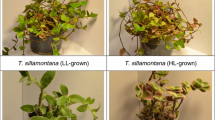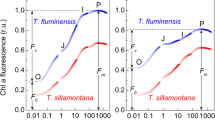Abstract
Photoinhibitory processes in the photosynthetic apparatus of the seedlings of Abies alba (Mill.), Picea abies (Karst.), and Pinus mugo (Turra) growing under strong shade (5 % of full solar irradiance) or full irradiance conditions were investigated in winter and spring using chlorophyll a fluorescence techniques. The extent of photoinhibition in needles as indicated by a decrease in maximum quantum yield of PS II photochemistry (Fv/Fm) depended on species, air temperature and acclimation to the light environment. Unexpectedly, shade-tolerant Abies alba was less affected by low-temperature photoinhibition compared to the other species. Fv/Fm recovered with increasing air temperature. During winter, the seedlings of Picea abies growing in shade showed higher Fv/Fm than those from full light. Non-photochemical quenching of fluorescence (NPQ) measured at the same levels of actinic light was higher in needles acclimated to full light except for Abies alba in February. Photosynthetic performance in term of ETR (apparent electron transfer rate) was also higher in full light-acclimated needles. In April, at ambient temperature, recovery of PS II efficiency from the stress induced by illumination with saturating light was faster in the needles of Picea abies than in those of Abies alba. The shade-acclimated needles of Abies alba and Picea abies showed greater down-regulation of PS II induced by high light stress.
Similar content being viewed by others
Abbreviations
- ETR:
-
apparent electron transport rate (µmol m−2 s−1)
- ETRmax :
-
maximum value of ETR
- Fv/Fm :
-
maximum quantum yield of photosytem II photochemistry
- Fm :
-
maximum fluorescence yield
- F’m :
-
maximum fluorescence in the light
- F0 :
-
minimum fluorescence yield
- Fs :
-
steady-state fluorescence yield
- NPQ:
-
non-photochemical quenching of fluorescence
- PPFD:
-
photosynthetic photon flux density (µmol m−2 s−1)
- PPFDsat :
-
saturation level of photosynthetic photon flux density
- PSII:
-
photosystem II
- ΦPSII :
-
quantum yield of PSII photochemistry
References
Adams W. W. III, Demmig-Adams B. 1994. Carotenoid composition and down regulation of photosystem II in three conifer species during the winter. Physiol. Plant. 92: 451–458.
Adams W.W. III, Zarter C.R., Ebbert V., Demmig-Adams B. 2004. Photoprotective strategies of overwintering evergreens. BioScience, 54: 41–49.
Anderson M.J., Park Y.-I., Chow W.S. 1997. Photoinactivation and photoprotection of photosystem II in nature. Physiol. Plant. 100: 214–223.
Genty B., Briantais J-M., Baker N.R. 1989. The relationship between the quantum yield of photosynthetic electron transport and quenching of chlorophyll fluorescence. Biochm. Biophys. Acta, 990: 87–92.
Groom J. Q., Baker R. N. and Long P. S. 1991. Photoinhibition of holly (Ilex aquifolium) in the field during the winter. Physiol. Plant. 83: 585–590.
Han Q., Katahata S., Kakubari Y., Mukai Y. 2004. Seasonal changes in the xanthophyll cycle and antioxidants in sun-exposed and shaded parts of the crown of Cryptomeria japonica in relation to rhodoxanthin accumulation during cold acclimation. Tree Physiol. 24: 609–616.
Jifon L. J., Syversten P. J. 2003. Moderate shade can increase net gas exchange and reduce photoinhibition in citrus leaves. Tree Physiol. 23: 119–127.
Kitao M., Lei T. T., Koike T., Tobita H., Maruyama Y. 2000. Susceptibility to photoinhibition of three deciduous broadleaf tree species with different successional traits raised under various light regimes. Plant Cell Environ. 23: 81–89.
Krause H. G., Koroleva Y. O., Dalling W. J., Winter K. 2001. Acclimation of tropical tree seedlings to excessive light in simulated tree-fall gaps. Plant Cell Environ. 24: 1345–1352.
Lambers, H., Stuart Chapin III, F., Pons, L.T. 1998. Plant Physiological Ecology. Springer, pp. 34.
Lovelock E. C., Kursar A. T., Skillman B. J., Winter K. 1998. Photoinhibition in tropical forest understorey species with short- and long-lived leaves. Funct. Ecol. 12: 553–560.
Maxwell K., Johnson N.G. 2000. Chlorophyll fluorescence — a practical guide. J. Exp. Bot. 51: 659–668.
Pocock H.T., Hurry V., Savitch V.L. and Huner A.P. N. 2001. Susceptibility to low-temperature photoinhibition and the acquisition of freezing tolerance in winter and spring wheat: The role of growth temperature and irradiance. Physiol. Plant. 113: 499–506.
Rascher U., Liebieg M., Lüttge U. 2000. Evaluation of instant light-response curves of chlorophyll fluorescence parameters obtained with a portable chlorophyll fluorometer on site in the field. Plant, Cell and Environ. 23: 1397–1405.
Robakowski P., Wyka T. 2004. Down-regulation of PS II in needles of silver fir (Abies alba Mill.) seedlings growing under the canopy of European larch and Norway spruce. Zeszyty Problemowe Post pów Nauk Roiniczych 496: 421–431.
Senevirathna K W. M. A., Stirling M. C., Rodrigo L. H. V. 2003. Growth, photosynthetic performance and shade adaptation of rubber (Hevea brasiliensis) grown in natural shade. Tree Physiol. 23: 705–712.
Somersalo S., Krause H. G. 1990. Photoinhibition at chilling temperatures and effects of freezing stress on cold acclimated spinach leaves in the field. Physiol. Plant. 79: 617–622.
van Wijk K. J. and van Hasselt P. R. 1993. Photoinhibition of photosystem II in vivo is preceded by down-regulation through light-induced acidification of the lumen: Consequences for the mechanism of photoinhibition in vivo. Planta 189: 359–368.
Verhoeven S. A., Adams W. W. III, Demmig-Adams B. 1996. Close relationship between the state of xanthophyll cycle pigments and photosystem II efficiency during recovery from winter stress. Physiol. Plant. 96: 567–576.
Weger H. G., Silim S. N., Guy R. D. 1993. Photosynthetic acclimation to low temperature by western cedar seedlings. Plant Cell Environ. 16: 711–718.
Author information
Authors and Affiliations
Rights and permissions
About this article
Cite this article
Robakowski, P. Species-specific acclimation to strong shade modifies susceptibility of conifers to photoinhibition. Acta Physiol Plant 27, 255–263 (2005). https://doi.org/10.1007/s11738-005-0001-y
Received:
Accepted:
Issue Date:
DOI: https://doi.org/10.1007/s11738-005-0001-y




